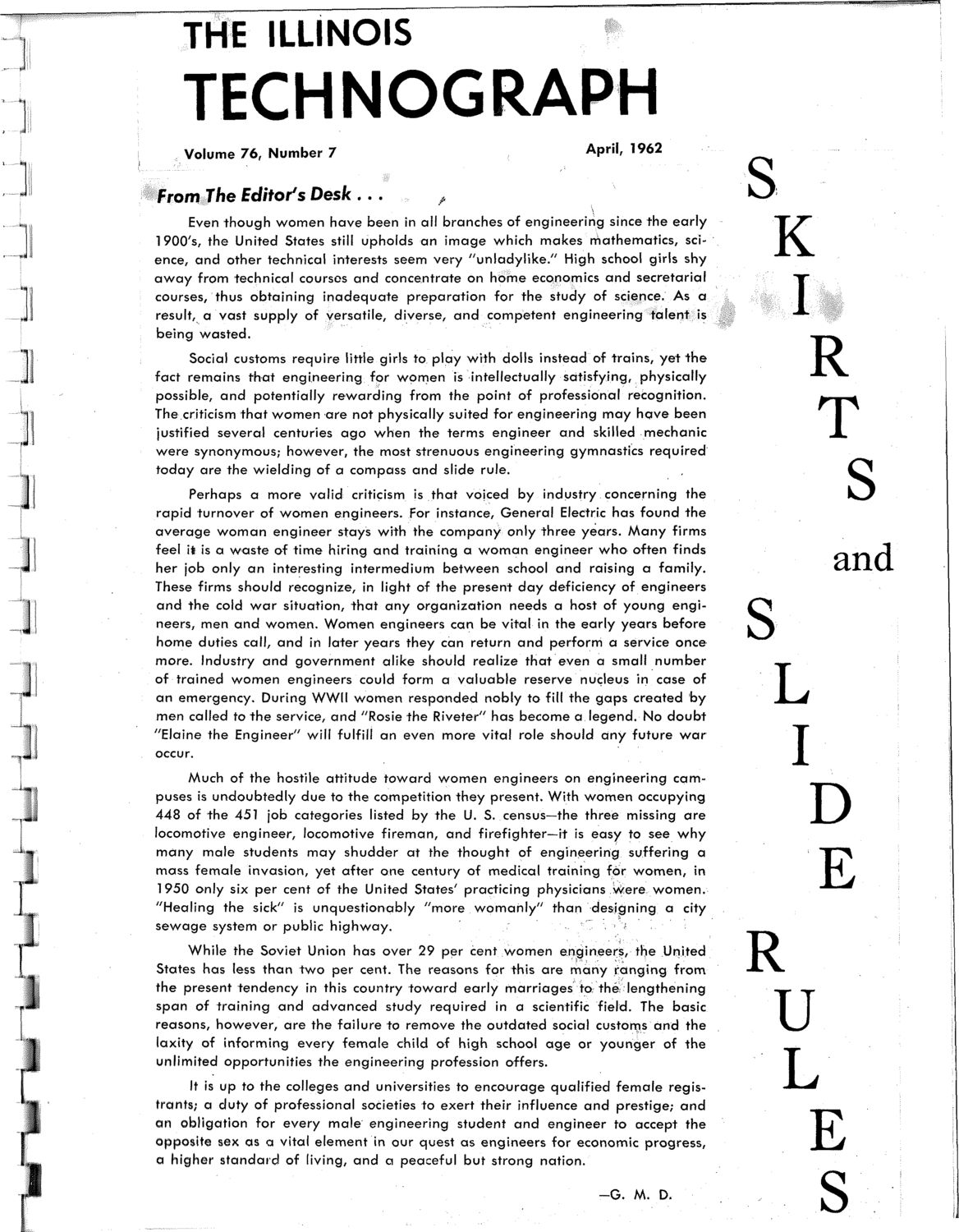| |
| |
Caption: SWE - News Clippings Book
This is a reduced-resolution page image for fast online browsing.

EXTRACTED TEXT FROM PAGE:
THE ILLINOIS TECH NOG RAPH Volume 76, Number 7 April, 1962 From The Editor's Desk . . . , Even though women have been in all branches of engineering since the early 1900's, the United States still upholds an image which makes mathematics, science, and other technical interests seem very "unladylike." High school girls shy away from technical courses and concentrate on home economics and secretarial courses, thus obtaining inadequate preparation for the study of science. As a result, a vast supply of versatile, diverse, and competent engineering talent is being wasted. Social customs require little girls to play with dolls instead of trains, yet the fact remains that engineering for women is intellectually satisfying, physically possible, and potentially rewarding from the point of professional recognition. The criticism that women are not physically suited for engineering may have been justified several centuries ago when the terms engineer and skilled mechanic were synonymous; however, the most strenuous engineering gymnastics required today are the wielding of a compass and slide rule. Perhaps a more valid criticism is that voiced by industry concerning the rapid turnover of women engineers. For instance, General Electric has found the average woman engineer stays with the company only three years. Many firms feel it is a waste of time hiring and training a woman engineer who often finds her job only an interesting intermedium between school and raising a family. These firms should recognize, in light of the present day deficiency of engineers and the cold war situation, that any organization needs a host of young engineers, men and women. Women engineers can be vital in the early years before home duties call, and in later years they can return and perform a service once more. Industry and government alike should realize that even a small number of trained women engineers could form a valuable reserve nucleus in case of an emergency. During WWII women responded nobly to fill the gaps created by men called to the service, and "Rosie the Riveter" has become a legend. No doubt "Elaine the Engineer" will fulfill an even more vital role should any future w a r occur. Much of the hostile attitude toward women engineers on engineering campuses is undoubtedly due to the competition they present. With women occupying 448 of the 451 job categories listed by the U. S. census—the three missing are locomotive engineer, locomotive fireman, and firefighter—it is easy to see why many male students may shudder at the thought of engineering suffering a mass female invasion, yet after one century of medical training for women, in 1950 only six per cent of the United States' practicing physicians were women. "Healing the sick" is unquestionably "more womanly" than designing a city ! sewage system or public highway. '".. While the Soviet Union has over 29 per cent women engineers, the United States has less than two per cent. The reasons for this are many ranging from the present tendency in this country toward early marriages to the, lengthening span of training and advanced study required in a scientific field. The basic reasons, however, are the failure to remove the outdated social customs and the laxity of informing every female child of high school age or younger of the unlimited opportunities the engineering profession offers. It is up to the colleges and universities to encourage qualified female registrants; a duty of professional societies to exert their influence and prestige; and an obligation for every male engineering student and engineer to accept the opposite sex as a vital element in our quest as engineers for economic progress, a higher standard of living, and a peaceful but strong nation. - G . M. D.
| |